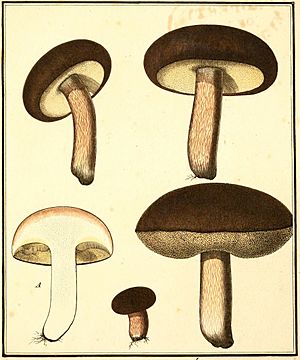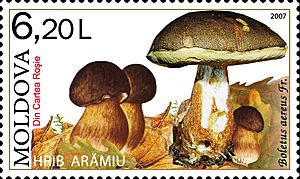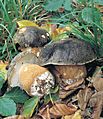Dark cep facts for kids
Quick facts for kids Dark cep |
|
|---|---|
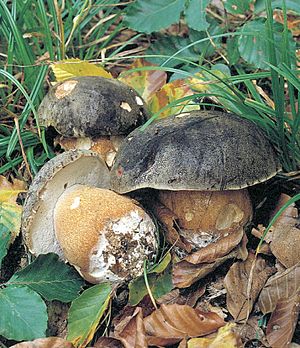 |
|
| Scientific classification | |
| Synonyms | |
|
| Boletus aereus | |
|---|---|
| Mycological characteristics | |
| pores on hymenium | |
| cap is convex | |
| hymenium is adnate | |
| stipe is bare | |
| spore print is olive-brown | |
| ecology is mycorrhizal | |
| edibility: choice | |
Boletus aereus, also known as the dark cep or bronze bolete, is a very popular and tasty edible mushroom. It belongs to the Boletaceae family. People love to eat this mushroom in places like Spain, France, Italy, and Greece.
A French scientist named Jean Baptiste François Pierre Bulliard first described this mushroom in 1789. It is related to other well-known European boletes, such as B. reticulatus, B. pinophilus, and the famous B. edulis. Some mushrooms found in North Africa were once thought to be a different type, B. mamorensis. But scientists now know they are the same as B. aereus.
This mushroom mostly grows near broad-leaved trees and bushes. It forms a special partnership called symbiosis with their roots. This means the mushroom's underground threads (called hyphae) wrap around the plant roots. The cork oak tree is a very important partner for this mushroom.
B. aereus grows its mushroom "fruit bodies" above ground in summer and autumn. These fruit bodies have a large, dark brown cap that can grow up to 30 centimeters (12 inches) wide. Unlike many mushrooms, B. aereus has tubes under its cap instead of gills. Spores escape through small openings called pores. The pores are whitish when young but turn greenish-yellow as the mushroom gets older. The short, thick brown stem can be up to 15 cm (6 inches) tall and 10 cm (4 inches) thick. It often has a raised net-like pattern on it.
Contents
About the Bronze Bolete
How it Got its Name
The French scientist Jean Baptiste François Pierre Bulliard gave Boletus aereus its name in 1789. The word aereus comes from Latin. It means "made with bronze or copper," which describes its dark, metallic color.
In 1886, another scientist, Lucien Quélet, tried to move it to a different group of mushrooms. But this change is not used anymore. For a while, some people thought it was a type of B. edulis.
Scientists also found a mushroom in Morocco that looked like B. aereus. They named it Boletus mamorensis in 1978. It had a reddish-brown cap and a stem with a net pattern mostly at the top. However, in 2010, scientists used genetic studies to compare these mushrooms. They found that B. mamorensis was actually the same species as B. aereus. It was just a slightly different version that grew in a specific environment.
In America, a mushroom that looked like Boletus aereus was found in California in 1975. But later studies showed it was a different species called Boletus regineus. It has a more jelly-like cap skin.
Boletus aereus is part of a group of mushrooms called Boletus section Boletus. Its close relatives include B. reticulatus, B. edulis, and B. pinophilus. Genetic studies show that B. aereus is very closely related to B. reticulatus.
Other Names for the Mushroom
Pierre Bulliard called Boletus aereus "the bronze bolete" in French. He also noted that some people called it the "black cep."
- In the Basque language, it's called ontto beltza, meaning "black fungus."
- In Italian, it's porcino nero, which means "black piglet."
- In French, it's Cèpe bronzé.
- In Greek, it's known as vasilikό (the royal one) or kalogeraki (little monk).
In English, it's often called the dark cep or bronze bolete.
What it Looks Like
The cap of Boletus aereus is shaped like a half-sphere or is slightly rounded. It can be 15 to 30 centimeters (6 to 12 inches) wide. Some have even been found as large as 40 cm (16 inches)! The cap feels a bit like velvet and can be dark brown, grayish-brown, or even purple-brown. It often has patches of copper, gold, or olive green.
The stem is 6 to 15 cm (2.5 to 6 inches) tall and 5 to 10 cm (2 to 4 inches) wide. It is usually shorter than the cap's width. At first, it looks like a barrel, but then it becomes wider at the top and narrower at the bottom. The stem is pale brown, reddish-brown, or chestnut-colored. It has a net-like pattern on it that is the same color as the stem or darker.
Like other boletes, this mushroom has tubes instead of gills under its cap. The small, round openings of these tubes are called pores. When young, the pores are whitish or grayish-white. They slowly turn yellowish or greenish-yellow as the mushroom grows. If you bruise them, they might turn a wine color. The tubes inside are white at first, then become yellowish or olive.
The mushroom's thick flesh is white. It has a strong, pleasant smell, a bit like hazelnuts. It tastes slightly sweet.
The mushroom's spores are shaped like spindles. They are 10.5 to 19 micrometers long and 4 to 7 micrometers wide.
Mushrooms That Look Similar
It's important to know the differences between Boletus aereus and other similar mushrooms.
- Boletus reticulatus looks very much like B. aereus. It also grows in summer under broad-leaved trees. However, its cap is usually paler and often has cracks. Its stem is also usually paler with a more noticeable white net pattern.
- Boletus pinophilus grows under conifer trees, especially Scots pine. It has a reddish-brown cap.
- Boletus edulis appears later in the year when it's cooler, mostly under Spruce trees. It has a paler, sticky cap and a paler stem with a sharp white net pattern.
Where it Grows
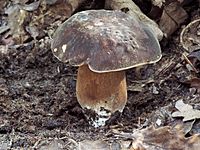
The amount of Boletus aereus found can vary a lot. It grows mainly in central and southern Europe, as well as North Africa. It is rare in colder places like England. In the Czech Republic, it is considered a vulnerable species. It is also on a list of endangered species in Montenegro.
However, in some places, it can be very common. For example, it is the most common bolete in the woodlands of Madonie Regional Natural Park in northern Sicily. Boletus aereus has also been found on several islands in the Mediterranean Sea, such as Corsica, Cyprus, Lesvos, and Naxos.
These mushrooms are usually found during warm periods in summer and autumn. They grow in a special partnership called mycorrhiza with different broad-leaved trees and shrubs. These include oak, beech, chestnut, strawberry trees, treeheath, and rockrose. They prefer acid soils. You can often find them along roadsides and in parks. The cork oak tree is a very important partner for B. aereus. The mushroom's presence matches where these trees grow across Europe and North Africa.
Scientists have studied how B. aereus forms its special connection with sweet chestnut and downy oak trees. This connection involves the mushroom's threads wrapping around the tree roots.
In the past, this mushroom was also reported in China. But recent genetic studies show that the boletes found in Asia are likely different species.
Eating and Cooking it
Boletus aereus is a fantastic edible mushroom. People in Southern Europe really love it for cooking. Many even think it tastes better than Boletus edulis. In a place called Borgo Val di Taro in Italy, four types of boletes, including B. aereus, are famous for their great taste. They are officially called Fungo di Borgotaro. People have been collecting and selling these mushrooms there for hundreds of years. In Spain, it's one of the most common wild mushrooms collected to eat.
When you collect these mushrooms, you should leave the cap skin on. Just brush off any dirt. You can leave the pores unless they are old and soft. Boletus aereus is especially good for drying. Drying makes its flavor and smell even stronger!
You can dry mushrooms by slicing them and hanging them on a string near the kitchen ceiling. Another way is to clean them with a brush (don't wash them!). Then, place them in a basket or bamboo steamer over a boiler or hot water tank. Once they are dry, keep them in an airtight jar.
To use dried mushrooms, soak them in hot (but not boiling) water for about twenty minutes. The water will get the mushroom's flavor and can be used as a tasty broth for cooking. Even a small amount of dried B. aereus can make other mushroom dishes taste much better.
How Nutritious is it?
Scientists have studied Boletus aereus collected in Portugal to see its nutritional value. For every 100 grams of dried mushroom, there are 367 kilocalories of energy.
In 100 grams of dried mushroom, you'll find:
- 17.9 grams of protein
- 72.8 grams of carbohydrates
- 0.4 grams of fat
Fresh mushrooms are mostly water, about 92% water by weight. The main sugar in the dried mushroom is trehalose (4.7 grams per 100 grams). There's also some mannitol (1.3 grams). It also contains 6 grams of tocopherols, which is a type of vitamin E, and 3.7 grams of ascorbic acid (Vitamin C).
Images for kids
See also
 In Spanish: Boletus aereus para niños
In Spanish: Boletus aereus para niños


